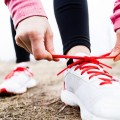Diabetic Foot Care — Protect to Prevent
People with diabetes may be prone to skin and foot problems. Here are a few simple things you can do every day to protect your skin and feet:
- Plan! Get plenty of rest. Sleep 7 to 8 hours each night. Children need even more sleep.
- Bathe daily. Clean skin reduces the likelihood of skin infections.
- Wear comfortable clothes. Clean socks and comfortable shoes are especially important.
- Space activities wisely.
- Dryness and other common skin problems
Dry skin can be caused by dehydration, which occurs in poorly controlled diabetes. Remember that excessive urination and thirst are symptoms of diabetes. For dry, itchy skin, try Alpha Keri bath oil. A capful in bath water softens and lubricates your skin. But be careful — bath oil makes your tub slippery. After bathing use a lanolin base cream to hold moisture in your skin.
Skin infections
People with poorly controlled diabetes are prone to skin infections because elevated blood sugar reduces the effectiveness of bacteria-fighting cells. Carbuncles, boils, and other skin infections may be hazardous if not properly treated. Even a small cut may progress to a deep, open sore, called an ulcer, if not treated promptly. In most cases, good hygiene (clean skin) and good diabetic control will improve your body’s ability to resist infection. Sometimes, however, antibiotics are necessary.
Foot care
In long-term diabetes, blood circulation to and from the feet decreases, slowing the healing process for foot injuries. Because nerves in the feet may not work well, you may not feel small foot injuries and therefore you may fail to treat them promptly. Untreated foot injuries can become infected or ulcerated.
To avoid foot problems, take steps for proper diabetic foot care, such as to keep your feet clean and wear comfortable shoes and socks at all times. Keep your feet warm, and take care of toenails and calluses. See a podiatrist (foot specialist) and when you visit your doctor, make sure he or she checks your feet (socks off) during the examination.
If you notice any change in sensation in your feet, contact your doctor or diabetes educator at once.
Foot care do’s and don’ts
Do:
- Check your feet daily for red spots, bruises, cuts, blisters, and dryness or cracks in the skin. Don’t forget under and between toes. Press gently and feel for tenderness or hot spots — this may indicate injury.
- Every day, wash your feet with mild soap and dry them thoroughly, especially between the toes.
- If the skin on your feet is dry, apply a lanolin base cream (but not between the toes). If your feet perspire a lot, use talcum powder.
- Wear good-fitting, soft shoes and clean socks. Smooth out wrinkles in socks. Choose new shoes carefully (comfort is more important than style) and break them in slowly.
- Avoid foot injuries by wearing shoes or slippers around the house and swim slippers at the beach or pool.
- Wear insulated boots to keep feet warm on cold days.
- Trim toenails to the contour of your toe. If you can’t see them well or reach them easily, have someone do this for you.
- Buff calluses with pumice stone.
Don’t:
- Put hot water bottles or heating pads on your feet.
- Soak your feet (this dries out natural oils).
- Cut corns or calluses or use corn pads or corn medication.
- Wear shoes that are two tight or worn out, or round garters or tight socks that cut off circulation.
Call your Podiatrist if you have:
- A puncture wound, any foot injury that does not heal, or any pus from cuts
- Red spots (even if there is no pain) under corns and calluses
- Ingrown toenails, or thick toenails, corns, or calluses that are difficult to care for
- First aid for foot injuries
You may feel no pain when you injure your foot, but that doesn’t mean you can ignore the injury.
- Wash the injury with mild soap and dry thoroughly.
- Then apply a mild antiseptic (for example, Polysporin ointment).
- Do not use iodine, Epsom salts, or boric acid.
- If a bandage is necessary, use a small gauze pad and non-allergic tape (regular tape can irritate your skin).
- Rest with the injured foot up for 20 minutes several times a day.
Athlete’s foot
- Athlete’s foot is a fungus infection that causes itchiness and broken skin, often between toes. It may look like tiny blisters or scaly, dry skin. Athlete’s foot is contagious; you can catch it from contact with bathroom floors and the floors of public locker rooms. Because broken skin may lead to other infections, you must try to prevent athlete’s foot and treat it when it occurs.
- To prevent athlete’s foot, wear bath slippers in public bath houses and showers.
- If you experience symptoms of athlete’s foot, apply an antifungal ointment (Tinactin or Desinex). Treat your shoes with an anti-fungal powder.
Information from the University of Massuchusetts Medical Center Worcester, MA








